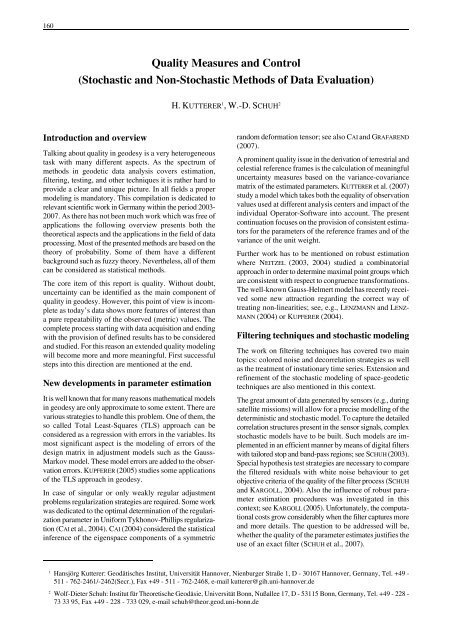NATIONAL REPORT OF THE FEDERAL REPUBLIC OF ... - IAG Office
NATIONAL REPORT OF THE FEDERAL REPUBLIC OF ... - IAG Office
NATIONAL REPORT OF THE FEDERAL REPUBLIC OF ... - IAG Office
Create successful ePaper yourself
Turn your PDF publications into a flip-book with our unique Google optimized e-Paper software.
160<br />
Quality Measures and Control<br />
(Stochastic and Non-Stochastic Methods of Data Evaluation)<br />
Introduction and overview<br />
Talking about quality in geodesy is a very heterogeneous<br />
task with many different aspects. As the spectrum of<br />
methods in geodetic data analysis covers estimation,<br />
filtering, testing, and other techniques it is rather hard to<br />
provide a clear and unique picture. In all fields a proper<br />
modeling is mandatory. This compilation is dedicated to<br />
relevant scientific work in Germany within the period 2003-<br />
2007. As there has not been much work which was free of<br />
applications the following overview presents both the<br />
theoretical aspects and the applications in the field of data<br />
processing. Most of the presented methods are based on the<br />
theory of probability. Some of them have a different<br />
background such as fuzzy theory. Nevertheless, all of them<br />
can be considered as statistical methods.<br />
The core item of this report is quality. Without doubt,<br />
uncertainty can be identified as the main component of<br />
quality in geodesy. However, this point of view is incomplete<br />
as today’s data shows more features of interest than<br />
a pure repeatability of the observed (metric) values. The<br />
complete process starting with data acquisition and ending<br />
with the provision of defined results has to be considered<br />
and studied. For this reason an extended quality modeling<br />
will become more and more meaningful. First successful<br />
steps into this direction are mentioned at the end.<br />
New developments in parameter estimation<br />
It is well known that for many reasons mathematical models<br />
in geodesy are only approximate to some extent. There are<br />
various strategies to handle this problem. One of them, the<br />
so called Total Least-Squares (TLS) approach can be<br />
considered as a regression with errors in the variables. Its<br />
most significant aspect is the modeling of errors of the<br />
design matrix in adjustment models such as the Gauss-<br />
Markov model. These model errors are added to the observation<br />
errors. KUPFERER (2005) studies some applications<br />
of the TLS approach in geodesy.<br />
In case of singular or only weakly regular adjustment<br />
problems regularization strategies are required. Some work<br />
was dedicated to the optimal determination of the regularization<br />
parameter in Uniform Tykhonov-Phillips regularization<br />
(CAI et al., 2004). CAI (2004) considered the statistical<br />
inference of the eigenspace components of a symmetric<br />
H. KUTTERER 1 , W.-D. SCHUH 2<br />
random deformation tensor; see also CAI and GRAFAREND<br />
(2007).<br />
A prominent quality issue in the derivation of terrestrial and<br />
celestial reference frames is the calculation of meaningful<br />
uncertainty measures based on the variance-covariance<br />
matrix of the estimated parameters. KUTTERER et al. (2007)<br />
study a model which takes both the equality of observation<br />
values used at different analysis centers and impact of the<br />
individual Operator-Software into account. The present<br />
continuation focuses on the provision of consistent estimators<br />
for the parameters of the reference frames and of the<br />
variance of the unit weight.<br />
Further work has to be mentioned on robust estimation<br />
where NEITZEL (2003, 2004) studied a combinatorial<br />
approach in order to determine maximal point groups which<br />
are consistent with respect to congruence transformations.<br />
The well-known Gauss-Helmert model has recently received<br />
some new attraction regarding the correct way of<br />
treating non-linearities; see, e.g., LENZMANN and LENZ-<br />
MANN (2004) or KUPFERER (2004).<br />
Filtering techniques and stochastic modeling<br />
The work on filtering techniques has covered two main<br />
topics: colored noise and decorrelation strategies as well<br />
as the treatment of instationary time series. Extension and<br />
refinement of the stochastic modeling of space-geodetic<br />
techniques are also mentioned in this context.<br />
The great amount of data generated by sensors (e.g., during<br />
satellite missions) will allow for a precise modelling of the<br />
deterministic and stochastic model. To capture the detailed<br />
correlation structures present in the sensor signals, complex<br />
stochastic models have to be built. Such models are implemented<br />
in an efficient manner by means of digital filters<br />
with tailored stop and band-pass regions; see SCHUH (2003).<br />
Special hypothesis test strategies are necessary to compare<br />
the filtered residuals with white noise behaviour to get<br />
objective criteria of the quality of the filter process (SCHUH<br />
and KARGOLL, 2004). Also the influence of robust parameter<br />
estimation procedures was investigated in this<br />
context; see KARGOLL (2005). Unfortunately, the computational<br />
costs grow considerably when the filter captures more<br />
and more details. The question to be addressed will be,<br />
whether the quality of the parameter estimates justifies the<br />
use of an exact filter (SCHUH et al., 2007).<br />
1 Hansjörg Kutterer: Geodätisches Institut, Universität Hannover, Nienburger Straße 1, D - 30167 Hannover, Germany, Tel. +49 -<br />
511 - 762-2461/-2462(Secr.), Fax +49 - 511 - 762-2468, e-mail kutterer@gih.uni-hannover.de<br />
2 Wolf-Dieter Schuh: Institut für Theoretische Geodäsie, Universität Bonn, Nußallee 17, D - 53115 Bonn, Germany, Tel. +49 - 228 -<br />
73 33 95, Fax +49 - 228 - 733 029, e-mail schuh@theor.geod.uni-bonn.de











